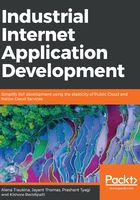
上QQ阅读APP看书,第一时间看更新
Industrial M2M protocols – Modbus
In this section, we will try to build a simple IoT application for sending data from a sensor simulator module to a receiver device (a PC or a cloud), using a Raspberry Pi hub and the Modbus protocol:

Data flow from a sensor simulator to a receiver device
For devices with limited hardware resources, it makes sense to use the Modbus protocol for serial communication. While simple, it has several open and proprietary implementations that vary in functionality.
Note that this protocol can be used on the transport layer, but, in our example, we are going to use Modbus TCP, working on the application level.
In the following table, you can find a more detailed description of the protocol to understand whether it is suitable for your needs:
Key Value
Open source Yes*
The OSI layer Transport or an application
Data types Integer, float, string, Boolean
Limitations
- No support for large binary objects
- The master node regularly polls each device for data modifications*
- Maximum 254 devices addressed on a single data link*
- Only contiguous transmissions are allowed
Possible operations Read and write registers and coils, diagnostics
Latency High
Usage SMS, GPRS, wireline, wireless, mesh communication
Security No
Compression No
Table 4: The Modbus protocol specifications
The values marked with * are not applicable to all implementations of the Modbus protocol.
For building the application, we will need the following:
- Required software:
- Node.js 6+ (https://nodejs.org/en/download/)
- PostgreSQL (https://www.postgresql.org/download/)
- The Cloud Foundry CLI (https://github.com/cloudfoundry/cli#downloads)
- Request (https://www.npmjs.com/package/request)
- Modbus (https://www.npmjs.com/package/modbus)
- Docker (https://docs.docker.com/engine/installation/)
- Required hardware:
- Raspberry Pi 3 (model B)
- A power adapter (2A/5V)
- A microSD card (8 GB+) and an SD adapter
- An Ethernet cable for a wired network connection